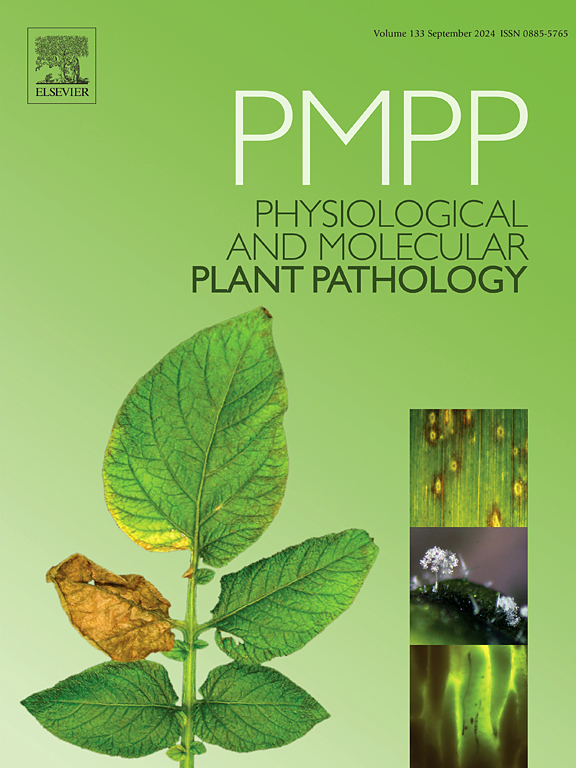Etiology and histopathological insights of twisted top disease: A re-emerging threat to sugarcane cultivation
IF 3.3
3区 农林科学
Q2 PLANT SCIENCES
引用次数: 0
Abstract
Sugarcane is an economically important sugar crop cultivated worldwide in tropical and subtropical regions. In recent years, Twisted top disease (TTD) also known as Pokkah boeng (PB) disease in sugarcane is a re-emerging disease causing epidemics in certain parts of India. The symptomatology of TTD, including twisted top and knife cut development were recorded with a maximum disease incidence up to 84.72 %. The pathogen was isolated separately from the leaf and stalk-associated symptoms and pathogenicity was confirmed through spindle and plug inoculation method. The isolates obtained from the sugarcane stalks were highly virulent and produced advanced TTD symptoms. These isolates were initially identified as Fusarium sp. based on morphological characterization. Subsequent multi-locus sequencing using ribosomal internal transcribed spacer (ITS), β-tubulin (tub2) and translation elongation factor 1- alpha (TEF-1α) identified them as F. proliferatum, F. verticillioides, F. andiyazi and F. sacchari. Furthermore, the phylogenetic analysis revealed that all isolates were grouped within the Fusarium fujikuroi species complex (FFSC). The mycotoxin biosynthesis encoding genes such as fumonisin (FUM1), fusaric acid (FUB10) and beauvericin (bsyn1) were detected in the Fusarium species associated with TTD. To our knowledge, this study represents the first investigation of histopathological changes associated with TTD and reports the plugging of vascular tissues in advanced symptoms. These findings on the etiology and histopathology of TTD provide insights for developing an effective disease management strategy to target the Fusarium pathogen responsible for TTD development.
扭曲顶端病的病因学和组织病理学见解:对甘蔗种植的重新出现的威胁
甘蔗是全球热带、亚热带地区重要的经济糖料作物。近年来,甘蔗扭顶病(TTD)也被称为Pokkah boeng (PB)病,是一种重新出现的疾病,在印度某些地区引起流行。TTD的症状包括扭曲顶部和刀切发展,最高发病率为84.72%。将病原菌从叶片和茎秆中分离出来,通过梭形和塞形接种法确定致病性。从甘蔗茎中分离得到的菌株毒力强,并产生晚期TTD症状。根据形态特征初步鉴定这些分离株为镰刀菌。随后,利用核糖体内转录间隔序列(ITS)、β-微管蛋白(tub2)和翻译延伸因子1- α (TEF-1α)进行多位点测序,鉴定它们为F. proliferatum、F. verticillioides、F. anddiyazi和F. sacchari。系统发育分析表明,所有分离株均属于Fusarium fujikuroi species complex (FFSC)。在与TTD相关的镰刀菌中检测到真菌毒素合成编码基因伏马菌素(FUM1)、镰刀菌酸(FUB10)和beauvericin (bsyn1)。据我们所知,这项研究首次调查了与TTD相关的组织病理学变化,并报道了晚期症状中血管组织的堵塞。这些关于TTD病因学和组织病理学的发现为制定有效的疾病管理策略提供了见解,以针对负责TTD发展的镰刀菌病原体。
本文章由计算机程序翻译,如有差异,请以英文原文为准。
求助全文
约1分钟内获得全文
求助全文
来源期刊
CiteScore
4.30
自引率
7.40%
发文量
130
审稿时长
38 days
期刊介绍:
Physiological and Molecular Plant Pathology provides an International forum for original research papers, reviews, and commentaries on all aspects of the molecular biology, biochemistry, physiology, histology and cytology, genetics and evolution of plant-microbe interactions.
Papers on all kinds of infective pathogen, including viruses, prokaryotes, fungi, and nematodes, as well as mutualistic organisms such as Rhizobium and mycorrhyzal fungi, are acceptable as long as they have a bearing on the interaction between pathogen and plant.

 求助内容:
求助内容: 应助结果提醒方式:
应助结果提醒方式:


